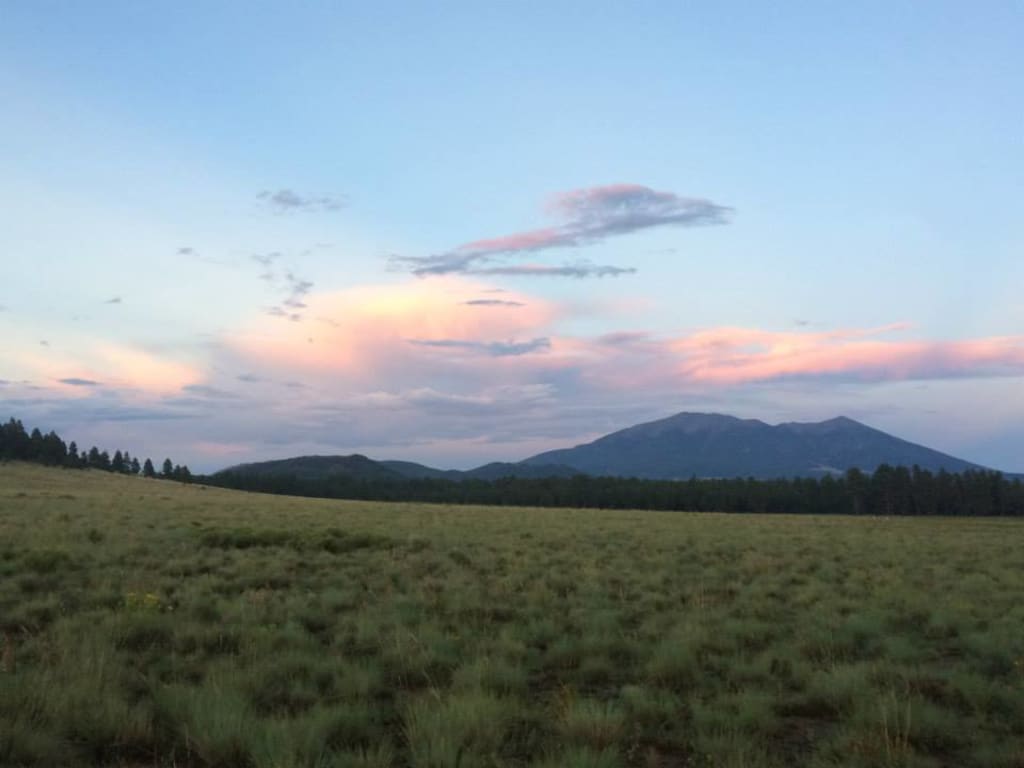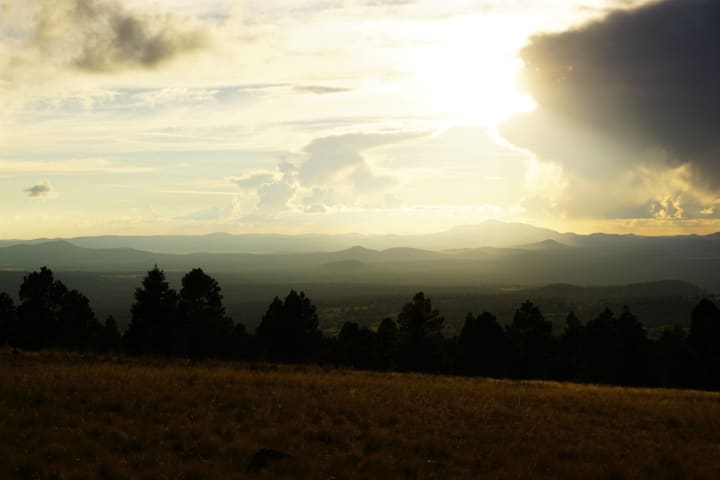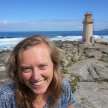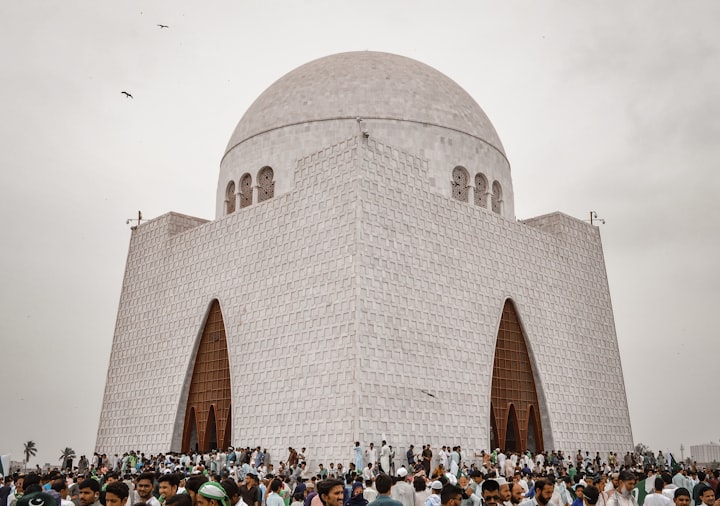Dark Sky
An essay on a mountain town, gravity, and time

What I miss the most about Flagstaff is the night sky.
From the side street next to my house I could look up at the end of any day and see the bright splatter of stars so close, I felt the light in my fingertips. I would come home at the end of the day, walking in the dark the one mile from my office on campus, and stare up for one lingering moment before I punched in the code for the garage door and waited for it to open. I would stare into the night, feet tired and brain weary, and catch the firmly edge of the Milky Way loping above Mackenzie Drive. I traced my eyes in a weighty ellipse around the edges of the galaxy, and I could almost feel its rotation.
---
I arrived in Flagstaff in August, a week before my roommates. I had two weeks of teacher training at the intensive English school, where I would be serving as a graduate teaching assistant while working on my master’s. I went to all the sessions and dutifully met with my advisors, and planned lessons with genuine excitement. But the minute we were permitted to leave, on those hot weightless summer afternoons, I skipped all optional mixers and get-to-know-you program events and went straight to the climbing.
When I learned I would be moving to Arizona, I began stalking the climbing Facebook pages, trying to find partners. I had chalk dust in my soul and limestone in my eyes. I wanted rock, and friends, and I wanted them quick.
Flagstaff delivered. I spent evenings at the local climbing gyms meeting up with people who had replied to my posts. One Saturday, I made my first trip to the local crag, Le Petit Verdon, usually shortened to “The Pit,” a wonderland of well-loved pocketed limestone just off Sandy’s Canyon and the Arizona Trail. I’d agreed to meet up with a climber who had commented on my Facebook post and sounded more experienced than I was with outdoor climbing.
It was he that I met on this day, unfolding like a meerkat from his tiny car, sheet-blond hair swishing in the wind. He held a rope and a backpack full of quickdraws and carabiners that clinked as we walked on the trail down into the canyon and back up to the face of the rock.
We climbed for hours. I breathed in the sweet vanilla smell of Ponderosa pine, disbelieving that I now actually lived here. My fingertips traced the well-established routes, clicking metal to metal and skin to limestone. Arms shaking, I ascended. Hello, came a sound from somewhere inside me, face to the rock with ravens above. It is so nice to meet you.
---
Percival Lowell was convinced there was another planet. Neptune and Uranus were in the wrong place, he said. If they occupied the space calculated for them, all would be right. But there was something affecting their positions, he thought, some kind of unforeseen gravity. He knew there was something else there.
Lowell founded an observatory in Flagstaff that bears his name. It was here that he researched and recalculated, searching the skies for his Planet X beyond the known reaches of the Solar System. It eluded him. For eleven years at Lowell Observatory he labored over the mathematics, using cameras and telescopes, but found nothing. The tools were not strong enough and the math wasn’t right. Lowell died in 1916, before he would learn of Pluto’s existence.
The planet–now dwarf planet–was ultimately discovered at Lowell Observatory on February 18, 1930, by Clyde Tombaugh. On March 13, Percival Lowell’s birthday, the observatory announced the discovery.
Pluto’s astronomical symbol is a stylized P and L together in one character, both in recognition of the name of the planet and of the efforts of Percival Lowell–P.L.–to discover it.
As it turns out, Lowell’s theory was wrong. Pluto’s mass was too small to substantially affect the position of the other planets. Thus in 2006, NASA announced that Pluto would no longer be classified as a planet, but rather a dwarf planet. Despite the incorrectness of the Planet X theory, Lowell’s postulation that there was something further out there had been correct.
Pluto didn’t affect the other planets much, but there it was, just the same. Almost invisible, just at the edge of the known system. A small entity rotating round what was already known. One little piece of the sky in all its dark space and pinpricks of light.
---
It took me the better part of an hour to lead climb the route: a long, weird 5.8 on a corner of the limestone that jutted out above the trees. This was my first outdoor lead, and I was shaking. The beginning was easy but the bolts thinned out the farther up I got. The silence, broken only by the occasional caw of a raven or a dry breeze rolling up from the canyon, both calmed and terrified me.
My new friend, the lanky climber with the long blond hair, belayed me patiently from below. “You’ve got this,” he yelled up to me, over and over. I took a breath, climbed up, and reached the anchor. Click, said the quickdraw against the metal chain. Click, said the carabiner gate as it closed.
“Take!” I yelled. “I’m done, thank God.” The rope tightened and I relaxed my weight into it.
It was well into the afternoon when we had finished with climbing for the day, but I didn’t want to be done. I was drunk on the mountains and the rock, the chalk and the smell of sweat, and the excitement of maybe, possibly, having a new friend.
It seemed like he didn’t want to be done yet, either. “Hey, have you heard of the Lava River Cave?” he asked once we reached the parking lot.
I shook my head no.
“It’s an underground tunnel formed by lava flows. It’s a cool spot. Would you want to go tonight?”
A few hours later he and I were driving northwest on Route 180, below the towering San Francisco Peaks, the road weaving through increasingly thick forest. We arrived at the cave and descended into its rocky mouth. There were other hikers there, identified only by their headlamps and voices. At the end of the cave, we sat on a wide flat rock, and turned off our lights. There was thick black darkness, molasses-smooth.
It was dusk when we emerged. The sky was cotton candy blue, blending into creamy pink and purple behind the mountains. Instead of turning right to go back to the main road, he took a left on the gravel, and we stopped and got out at a prairie beneath a grassy hill.
Something possessed him to yell. The valley echoed back profoundly, tossing his voice from hilltop to brush to trees and back. A smile erupted across both our faces.
“Have you ever heard an echo like that?”
We yelled and yodeled and sang at the mountains then, the world sliding into night. Our voices praised the grass and the birds and the craggy mountains, the pines with their sap and the sky with its stars, blinking sleepily awake in the twilight.
---
Buffalo Park sits on the McMillan Mesa beneath Mount Elden and the Peaks in the northeast corner of Flagstaff. It is a wide, flat park, with a long walking path around its perimeter and fields of native grasses ringed by forested ravines. On some clear nights, the Flagstaff Star Party sets up telescopes at the park and invites people to come and look into the havens.
I went once, in my first fall in Arizona. It was a crisp night, the world poised on the edge of autumn. The organizers handed out red LED lights–headlamps were not permitted. Up and down the wide gravel walkway, red dots of light flickered like so many insect eyes. Every hundred yards or so was a telescope, each with its respective astronomer inviting walkers to take a peek through the lens and get a closer view of the night sky.
It was getting cloudy by the time I arrived there, so some of the telescopes were unable to find the stars. But one of them, a rather large setup that required me to step on a stool, was trained on Andromeda. Even in the telescope she wasn’t large, just a circular cluster of stars way out in space. Still, I smiled wide. From the lens of a machine of glass and metal, up to the nearest galaxy, there now existed a tenuous thread. A small, twinkling world and a little human stargazer, each on the edge of an unimaginable distance.
I stepped away from the telescope and looked up again. I could see the little powder cloud of Andromeda up there now, but just barely. Everywhere else, there were brighter lights, around and over and behind the mountains. I turned in circles, trying to take it all in.
---
We spent a lot of time together that fall, the long lanky climber and I. The semester began and I started my teaching career, in an old school building on the edge of campus with two level-one ESL students from Saudi Arabia. By day I planned lessons, taught them to listen and speak in English, held conversations and had fun in class. When I was done teaching, I went to my own classes. I relished the time in the academy and loved my students. But every day, the second I was free, I raced home on my bike, changed, and went climbing.
There was freedom in Arizona like I had never tasted before. Rock and pine trees crowded into vestiges of civility. The university felt held between the canyon walls and the mountains just north. I could see the peaks from every point on campus, teasing and tempting, bright gray-green teachers against the blue horizon. Every moment that I was not outside, I wanted to be. It was all I could think about.
One day, after a climbing club meeting, the climber asked me if I’d ever been night climbing. I said no. I had to try it, he said. It was really good here, especially at full moon. The light reflected off the limestone walls at the Pit so that you hardly needed a headlamp. Do you want to go?
So there we were a day later, driving in the early darkness down Lake Mary Road. It was a long stretch of smooth pavement heading southeast out of Flagstaff, and through the open windows came the thick, sweet smell of not-quite-autumn. Everything that night was saturated in pine and possibility, and I felt full of the music, Alt-J, pouring from the radio and into the night, full of the rock I would touch and the coyotes that would howl, and the stars that were just now beginning to peek out around the edges of darkness.
He had been right; we didn’t really need our headlamps except for the actual climbing. The moon was bright and its light dripped onto the limestone rock faces. We descended into the canyon and across, and back up to the base of an easy climb. He said I should lead it. So I did.
I put on my harness and clipped on my quickdraws, tied in my figure-eight, and chalked up. I put my hands to the rock. On belay? Belay is on. A breath and an owl song in the distance. Climbing. Climb on.
I felt the familiar pockets and edges of the rock, my hands and feet navigating easily. I reached a bolt, then another. Clip. Clip. In the day, I would have panicked, seeing the ground and recognizing my growing distance from it. But I couldn’t see the ground that night, and it was easy to pretend that it didn’t exist. It was neither a long nor a difficult climb, but I took it slowly, relishing the sensation of movement and strength I could feel gliding within my muscles, pushing me upward and into the night.
There was a small tree next to a ledge close to the top. This part was trickier, I remembered. My breath grew shaky. I found a good foothold, and rested. Somewhere down the canyon there were coyotes howling. There were owls in the distance, too. You’ve got this, said my belayer. I know. I know. There is strength somewhere within me, a place where the terror can’t reach. Just around the edge, a reach, one chalky shaking hand. Got it. I climbed up and over, clipped the anchors, and was done.
I sat for a moment before descending. The stars were properly out by now. They twinkled on in the darkness, as though switched on individually somewhere out in space. I enjoyed the way I could see them better from the side of my eye: Look straight ahead, and the lights go out. Look in the periphery, and they peek around cheekily. I smiled up at them.
I found myself here, unpredicted, hanging off the side of a rock in Arizona. Head-on, I could never have planned this moment. It was spontaneous and brilliant: in the darkness, alive and uncertain and, despite no calculation, exactly where I should be.
---
Flagstaff is an International Dark Sky City. This is why you can look up from East Mackenzie Drive and see the Milky Way on an average evening. In 2001 the city earned this recognition for its efforts to curb light pollution, impose restrictions on nighttime outdoor illumination, and preserve the ability to see the stars.
The coalition that worked for this Dark Sky designation held Lowell’s contributions in high regard. In the wake of the discovery of Pluto, several other major telescopes were set up in the area around Flagstaff, and a rich community of astronomical research blossomed. The region is ideal for stargazing, both professional and amateur. It sits at an elevation of nearly 7,000 feet, and its air is clear and dry. On a summer night, from the hill next to the observatory, the lights pop out the second it starts to get dark. The horizon turns vibrant pink behind the peaks and melts slowly over echoes and grasslands into the darkest night.
There are other cities in the American West that have worked to stay light pollution, but Flagstaff is among the most innovative, effective, and utterly dark. The coalition worked with local businesses to persuade them to shield their unnecessarily bright lights, install dimmer bulbs, and educate the public about the importance of the night sky. The result, after just a few short years, is a city that cherishes its legacy of loving the night.
There is a moment at dusk in Flagstaff when time, and all that has ever been, ceases. On the precipice between pastel twilight and night, the stars and planets hold their breath. There are no crickets, only pine sap and a sense of what is out there. Then time jolts, as if realizing its mistake, and plunges onward into bright, milky night.
---
I wanted to hold Flagstaff like a stone in my hand. Run its polished surface between my palms, press its weight to cheek and keep it safe. Stand beneath its hills and yell I see you, and you’re mine, and catch the echoes in a jar and shut it tight.
But Flagstaff is no trinket, and no one can possess its mountains, and echoes and pink loaming cannot be bottled, and the rotation marched onward, Earth and Pluto round our star in gravitational dance, delivering me to and from people, in and out of love, up and down the mountains, and, before I knew it, away.
---
Percivall Lowell is buried in a mausoleum atop a hill at the observatory that bears his name. It is designed to look like the building that holds a telescope. It is an ornate thing, perched on a view out across the valley and north to the peaks, and right in the center of the observatory complex.
Odd beliefs and incorrect calculations notwithstanding, Lowell touched Flagstaff. Had it not been for his confidence that something was hiding just out of sight beyond the reach of Neptune and Uranus, had it not been for his telescope, had it not been for his theories – would there be a Dark Sky City? Would there be a moon bright enough to light up the limestone? Who knows. Who knows.
On Lowell’s mausoleum there are carved inscriptions with excerpts from his various works. One of them, from The Evolution of Worlds, reads thus:
Everything around us on this Earth we see is subject to one inevitable cycle of birth, growth, decay. Nothing that begins but comes at last to end. Though our own lives are too brief even to mark the slow nearing to that eventual goal… Today what we already know is helping to comprehension of another world. In a not distant future we shall be repaid with interest and what that other world shall have taught us will redound to a better knowledge of our own and of the cosmos of which the two form part.
---
Birth, growth, decay. We notice phases and chapters only when they are almost past.
It was my last semester in Flagstaff. I had finished one program and was nearly done with a second. I wanted to draw out the learning and teaching and savor the mountains as long as I could. But I was beginning to realize that I could not keep hold forever.
One night in October, my last October in Flagstaff, I went out for drinks at a pub downtown with my new office-mates, who had become my friends. Even as I laughed and listened, drank and smiled, something gnawed inside me. Not only was I leaving the sky and the mountains, but I was also leaving these people I had just started to love. The conversation grew in turns loud and quiet, loud and raucous, and pool balls clicked, and fries were eaten, and it was late, and I said thank you and I should probably get home. I walked out to the parking lot and got in my car.
It moved down the road as if of its own accord, magnetlike and certain. Pine Knoll Drive was coming up, where I had to turn left to get home. But instead of turning I stayed in my lane, driving past the community college and into the forest. I made a right and then a left on Lake Mary Road. There were no other cars out that late at night. The moon wasn’t full but I could still see it, the confident waning three-quarters lighting up the pavement.
I rolled my windows down and turned up the volume, letting Alt-J croon into the air. I smelled the scent of pine and change and time reaching through me. More than three years had passed since I had first arrived here, but it felt, in that moment, like time had not moved at all.
If I could let myself slip away just slightly, I could believe that this night was that other, new night, driving in the dark down Lake Mary to the Pit, awash in moonlight and singing with coyote calls and owl songs. I could remember the invisible clanking of metal and the smell of flannel and chalk: love and exhilaration poised on the edge of a pin, ready to gravitate in either direction. I could taste the sweet newness of the place, the excitement of the trail ahead. I could almost suspend disbelief, and think that it was still that time.
But I knew that it was not the same night. Too much had changed, and too much rested on what was about to come, ungraspable and just past my line of sight.
---
What I miss the most about Flagstaff is the vastness. The ephemerality. The impossibility of holding on. The expansive radiance of a small town surrounded by mountains and rocks and open space. The people who lived here for centuries before us, the people who will come again. The mountains glowing beneath the moonlight. The cold stab of stars and the limestone canyons. A minor gravity in the wide lockstep of time, rotating on forever just past the edge of the observable present.

About the Creator
Sarahmarie Specht-Bird
A writer, teacher, traveler, and long-distance hiker in pursuit of a life that blends them all. Read trail dispatches and adventure stories at my website.






Comments
There are no comments for this story
Be the first to respond and start the conversation.